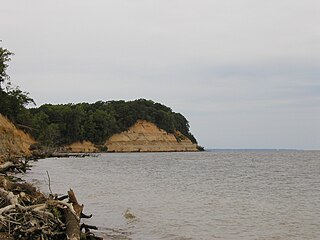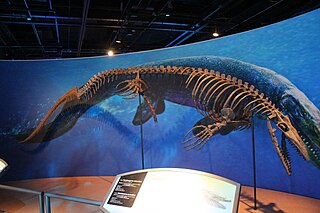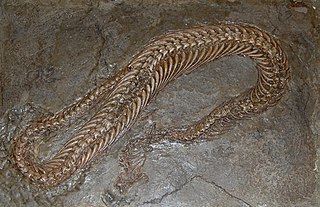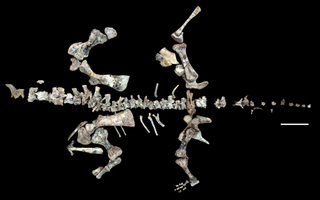Concentration of fossils
The area that goes from point 1 to point 3, is 185 metres (607 ft) in length and width is 5 metres (16 ft) on average, with exposed mudstone. In total there are 925 m2 (9,960 sq ft) of exposed mudstone. Five digs, where they entered a fossil for each 185 m2 (1,990 sq ft), so there should be fossils 50 per hectare, at this location.
In the circle, with the central point the point 3, the diameter is 340 m (1,120 ft), and the area is 90,792 m2 (977,280 sq ft). Dividing this area by 185 m2 (1,990 sq ft), probably have 490 fossils within this circle, which is in the map area. This estimate were considered, only the exposed area, as if in two dimensions, regardless of the depth.
There is a height difference of more than 3 meters between point 1 and point 3. All this indicates that fossils were deposited at this location for a long time, and there may be more fossils below the stream.
Assuming that each meter of depth there are four layers of fossils, means that the estimated number of 490 can be multiplied by four to give the 1960 fossil every meter deep excavated. Thus, it is likely that there are between 500-2000 fossils in this study area. But this number may be higher since there are two other sites nearby and 30 meters above the site. This means that this area can extrapolate in breadth and depth.

Mamenchisaurus is a genus of sauropod dinosaur known for their remarkably long necks which made up nearly half the total body length. Numerous species have been assigned to the genus; however, the validity of these assignments has been questioned. Fossils have been found in the Sichuan Basin and Yunnan Province in China. Several species from the Upper Shaximiao Formation, whose geologic age is uncertain, have been described. However, evidence suggests this formation to be no earlier than the Oxfordian stage of the Late Jurassic. M. sinocanadorum dates to the Oxfordian stage, and M. anyuensis to the Aptian stage of the Early Cretaceous. Most species were medium-large to large sauropods, measuring roughly 15 to 26 meters in length—possibly up to 35 meters (115 ft), based on two undescribed vertebrae.

Calvert Cliffs State Park is a public recreation area in Lusby, Calvert County, Maryland, that protects a portion of the cliffs that extend for 24 miles along the eastern flank of the Calvert Peninsula on the west side of Chesapeake Bay from Chesapeake Beach southward to Drum Point. The state park is known for the abundance of mainly Middle Miocene sub-epoch fossils that can be found on the shoreline.

Hyperodapedon is an extinct genus of rhynchosaur reptiles which lived during Late Triassic period. Like other rhynchosaurs, it was an heavily built archosauromorph, distantly related to archosaurs such as crocodilians and dinosaurs. Hyperodapedon in particular was part of the subfamily Hyperodapedontinae, a specialized rhynchosaurian subgroup with broad skulls, beaked snouts, and crushing tooth plates on the roof of the mouth.
Plotosaurus is an extinct genus of mosasaurs who lived during the Upper Cretaceous (Maastrichtian) in what is now North America. Only one species is recognized, P. bennisoni, described by Berkeley paleontologist Charles Lewis Camp in 1942 from fossils discovered in California. Originally named Kolposaurus, it was changed to Plotosaurus in 1951 when Camp discovered that the name had already been assigned to a type of nothosaur. Unlike other mosasaurids, Plotosaurus possesses a morphology converging with those of ichthyosaurs, suggesting a much more advanced swimming adaptation than some of its close relatives.
Angelosaurus is an extinct genus of herbivorous caseid synapsids that lived during the late Lower Permian (Kungurian) and early Middle Permian (Roadian) in what is now Texas and Oklahoma in the United States. Like other herbivorous caseids, it had a small head, large barrel-shaped body, long tail, and massive limbs. Angelosaurus differs from other caseids by the extreme massiveness of its bones, particularly those of the limbs, which show a strong development of ridges, processes, and rugosities for the attachment of muscles and tendons. Relative to its body size, the limbs of Angelosaurus were shorter and wider than those of other caseids. The ungual phalanges looked more like hooves than claws. The few known cranial elements show that the skull was short and more robust than that of the other representatives of the group. Angelosaurus is also distinguished by its bulbous teeth with shorter and wider crowns than those of other caseids. Their morphology and the high rate of wear they exhibit suggests a diet quite different from that of other large herbivorous caseids, and must have been based on particularly tough plants. A study published in 2022 suggests that the genus may be paraphyletic, with Angelosaurus possibly only represented by its type species A. dolani.

The Ischigualasto Formation is a Late Triassic geological formation in the Ischigualasto-Villa Unión Basin of southwestern La Rioja Province and northeastern San Juan Province in northwestern Argentina. The formation dates to the late Carnian and early Norian stages of the Late Triassic, according to radiometric dating of ash beds.

Dromicosuchus is an extinct genus of sphenosuchian, a type of basal crocodylomorph, the clade that comprises the crocodilians and their closest kin. It was found in Upper Triassic rocks of North Carolina, United States, and is known from a nearly complete skull and partial skeleton. This specimen is unusual in that it was found beneath the skeleton of a larger rauisuchian and has apparent bite damage, suggesting that it was attacked by the larger carnivore before both died and were buried together.
Mesosuchus is an extinct genus of basal Rhynchosaur from early Middle Triassic deposits of Eastern Cape, South Africa. It is known from the holotype SAM 5882, a partial skeleton, and from the paratypes SAM 6046, SAM 6536, SAM 7416 and SAM 7701 from the Aliwal North Euparkeria site. Mesosuchus is quite small, spanning around 30 cm in length. Mesosuchus was discovered and named by David Meredith Seares Watson in 1912.

Taniwhasaurus is an extinct genus of mosasaurs that lived during the Campanian stage of the Late Cretaceous. It is a member of the subfamily Tylosaurinae, a lineage of mosasaurs characterized by a long toothless conical rostrum. Two valid species are attached to the genus, T. oweni and T. antarcticus, known respectively from the fossil record of present-day New Zealand and Antarctica. Two other species have been nominally classified within the genus, T. 'capensis' and T. 'mikasaensis', recorded in present-day South Africa and Japan, but their attribution remains problematic due to the fragmentary state of their fossils. The generic name literally means "taniwha lizard", referring to a supernatural aquatic creature from Māori mythology.
Yarasuchus is an extinct genus of avemetatarsalian archosaur that lived during the Anisian stage of the Middle Triassic of India. The genus was named and described in 2005 from a collection of disarticulated but fairly complete fossil material found from the Middle Triassic Yerrapalli Formation. The material is thought to be from two individuals, possibly three, with one being much more complete and articulated than the other. The type and only species is Y. deccanensis. Yarasuchus was a quadruped roughly 2–2.5 metres (6.6–8.2 ft) long, with an elongated neck and tall spines on its vertebrae. Unlike other quadrupedal Triassic reptiles, the limbs and shoulders of Yarasuchus were slender, and more like those of ornithodirans.

Sanjuansaurus is a genus of herrerasaurid dinosaur from the Late Triassic (Carnian) Ischigualasto Formation of the Ischigualasto-Villa Unión Basin in northwestern Argentina.

Stenaulorhynchus is an extinct genus of hyperodapedontid rhynchosaur known from the Middle Triassic deposits of Tanganyika Territory, Tanzania. It was found in the Lifua Member of the Manda Formation in the Karoo Supergroup. It was named and first described by Sidney Henry Haughton in 1932. The type species is Stenaulorhynchus stockleyi, a beaked herbivore measuring 1–6 meters in length.

The Hilda mega-bonebed is a complex of fourteen probable Centrosaurus apertus bonebeds discovered near the town of Hilda in Alberta, Canada. It was first described in the scientific literature by David Eberth, Donald Brinkman, and Vaia Barkas in 2010 after more than ten years of research. The Hilda mega-bonebed is significant because the behavior of the preserved dinosaurs themselves was the dominant cause of its existence, rather than the stratum's geological history like most bonebeds. It is also Canada's largest bonebed.

Albertonectes is an extinct genus of elasmosaurid plesiosaur known from the Late Cretaceous Bearpaw Formation of Alberta, Canada. It contains a single species, Albertonectes vanderveldei. Albertonectes is the longest elasmosaur, and more generally plesiosaur, known to date both in neck and total body length.

Pachyophis is an extinct genus of Simoliophiidae snakes that were extant during the Cenomanian stage of the Late Cretaceous period. More specifically, it was found to be from the Cenomanian Age about 93.9-100.5 million years ago in the suburb area of Bileca, Herzegovina.

Shringasaurus is an extinct genus of archosauromorph reptile from the Middle Triassic (Anisian) of India. It is known from the type and only known species, S. indicus. Shringasaurus is known from the Denwa Formation in the state of Madhya Pradesh. Shringasaurus was an allokotosaur, a group of unusual herbivorous reptiles from the Triassic, and is most closely related to the smaller and better known Azendohsaurus in the family Azendohsauridae. Like some ceratopsid dinosaurs, Shringasaurus had two large horns over its eyes that faced up and forwards from its skull. Shringasaurus also bears convergent physical similarities to sauropodomorph dinosaurs, such as its long neck, its shoulders and forelimbs, and the shape of its teeth. Shringasaurus possibly occupied a similar ecological niche as a large browsing herbivore before such dinosaurs had evolved.

Mansourasaurus is a genus of herbivorous lithostrotian sauropod dinosaur from the Quseir Formation of Egypt. The type and only species is Mansourasaurus shahinae.

Nochnitsa is an extinct genus of gorgonopsian therapsids who lived during an uncertain stage of the Permian in what is now European Russia. Only one species is known, N. geminidens, described in 2018 from a single specimen including a complete skull and some postcranial remains, discovered in the red beds of Kotelnich, Kirov Oblast. The genus is named in reference to Nocnitsa, a nocturnal creature from Slavic mythology. This name is intended as a parallel to the Gorgons, which are named after many genera among gorgonopsians, as well as for the nocturnal behavior inferred for the animal. The only known specimen of Nochnitsa is one of the smallest gorgonopsians identified to date, with a skull measuring close to 8 cm (3.1 in) in length. The rare postcranial elements indicate that the animal's skeleton should be particularly slender.

Mistralazhdarcho is a genus of azhdarchid pterosaur from the Late Cretaceous period of France. The type and only species is Mistralazhdarcho maggii.

Thalassodraco is an extinct genus of ophthalmosaurid ichthyosaur from the Late Jurassic (Tithonian) Kimmeridge Clay Formation of England. The type species, T. etchesi, was named in 2020, with the epithet in honour of the discoverer of the holotype, Steve Etches.



















